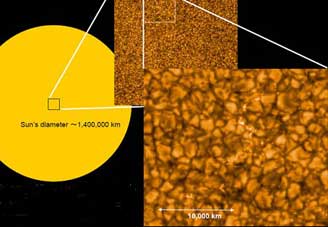Solar-B satellites send the first images to the Sun.
The September 22 Solar-B satellite from Japan collected the first images of the Sun to test and adjust the three carrying tools. The first images of the SOT optical telescope allow to see with high precision tiny particles covering the entire surface of the Sun.
Granulation is the result of convection: hot matter goes up to the surface, cools, becomes dense and falls. Each tiny particle has an average size of 1,500 km with a life span of about 10 minutes.
According to the Japanese Space Agency (JAXA), the resolution of the photos is 0.2 seconds of supply, equivalent to the size of a human hair 10 meters away.

The phenomenon of the Sun's particle formation seen from the SOT telescope (Photo: sciences.nouvelobs.com)
The Solar-B satellite was renamed Hinode by JAXA (Japanese for the rising Sun), with the mission to study the Sun's magnetic field in three-dimensional space, to understand the origin of the Sun's eruption. In addition to SOT, Hinode is also equipped with an X-ray telescope (XRT) that took the first photo on October 25 and an spectrometer (EIS) that was operational on October 28.
Hinode is a coordinated mission between British JAXA, NASA and PPARC. Adjustment of tools will continue this month and satellites will enter the scientific observation phase in early December.
VN
- Chinese artificial satellites provide images of the earth
- These photographs amazed solar storm
- Use satellites to send love letters into space
- NASA announces stunning images of Saturn
- Vietnamese people write names on the universe
- NASA: Will find alien life in the next 10 years
- Super big project NASA: Fly to the Sun.
- Use satellite data to detect ancient tomb theft
- Video: The most beautiful images ever seen about the Earth
- The moment the Sun rises on the Moon
- NASA launched two satellites to probe the radiation belt
- The F-1 satellite has not yet signaled
 Van Allen's belt and evidence that the Apollo 11 mission to the Moon was myth
Van Allen's belt and evidence that the Apollo 11 mission to the Moon was myth The levels of civilization in the universe (Kardashev scale)
The levels of civilization in the universe (Kardashev scale) Today Mars, the sun and the Earth are aligned
Today Mars, the sun and the Earth are aligned The Amazon owner announced a secret plan to build a space base for thousands of people
The Amazon owner announced a secret plan to build a space base for thousands of people Rare moment Mercury passes the Sun captured by spacecraft
Rare moment Mercury passes the Sun captured by spacecraft  Top 5 lands where the sun never sets, where 'sunset never reaches'
Top 5 lands where the sun never sets, where 'sunset never reaches'  Rare detailed image of sunspot
Rare detailed image of sunspot  Why are the sun's outer rings so much hotter than the inner core?
Why are the sun's outer rings so much hotter than the inner core?  'Planet 9' left its mark on Earth before disappearing?
'Planet 9' left its mark on Earth before disappearing?  Could the Sun Capture a New Planet, Changing Life on Earth?
Could the Sun Capture a New Planet, Changing Life on Earth? 